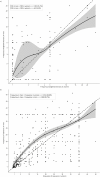Agreement in Occupational Exposures Between Men and Women Using Retrospective Assessments by Expert Coders
- PMID: 30124778
- PMCID: PMC6775225
- DOI: 10.1093/annweh/wxy074
Agreement in Occupational Exposures Between Men and Women Using Retrospective Assessments by Expert Coders
Abstract
Objectives: To estimate the level of agreement and identify notable differences in occupational exposures (agents) between men and women from retrospective assessments by expert coders.
Methods: Lifetime occupational histories of 1657 men and 2073 women from two case-control studies, were translated into exposure estimates to 243 agents, from data on 13882 jobs. Exposure estimates were summarized as proportions and frequency-weighted intensity of exposure for 59 occupational codes by sex. Agreement between metrics of exposure in men's and women's jobs was determined with intraclass correlation coefficients (ICC) and weighted Kappa coefficients, using as unit of analysis ('cell') a combination of occupational code and occupational agent. 'Notable' differences between men and women were identified for each cell, according to a Bayesian hierarchical model for both proportion and frequency-weighted intensity of exposure.
Results: For cells common to both men and women, the ICC for continuous probability of exposure was 0.84 (95% CI: 0.83-0.84) and 7.4% of cells showed notable differences with jobs held by men being more often exposed. A weighted kappa of 0.67 (95% CI: 0.61-0.73) was calculated for intensity of exposure, and an ICC of 0.67 (95% CI: 0.62-0.71) for frequency-weighted intensity of exposure, with a tendency of higher values of exposure metrics in jobs held by men.
Conclusions: Exposures were generally in agreement between men and women. Some notable differences were identified, most of them explained by differential sub-occupations or industries or dissimilar reported tasks within the studied occupations.
Figures
Similar articles
-
Using hierarchical cluster models to systematically identify groups of jobs with similar occupational questionnaire response patterns to assist rule-based expert exposure assessment in population-based studies.Ann Occup Hyg. 2015 May;59(4):455-66. doi: 10.1093/annhyg/meu101. Epub 2014 Dec 3. Ann Occup Hyg. 2015. PMID: 25477475 Free PMC article.
-
Bayesian Hierarchical Modelling of Individual Expert Assessments in the Development of a General-Population Job-Exposure Matrix.Ann Work Expo Health. 2020 Jan 1;64(1):13-24. doi: 10.1093/annweh/wxz077. Ann Work Expo Health. 2020. PMID: 31671187
-
Inter-rater reliability of occupational exposure assessment in a case-control study of female breast cancer.J Occup Environ Hyg. 2021 Oct-Nov;18(10-11):522-531. doi: 10.1080/15459624.2021.1976412. Epub 2021 Oct 11. J Occup Environ Hyg. 2021. PMID: 34491879
-
Sex and Gender Differences in Occupational Hazard Exposures: a Scoping Review of the Recent Literature.Curr Environ Health Rep. 2021 Dec;8(4):267-280. doi: 10.1007/s40572-021-00330-8. Epub 2021 Nov 27. Curr Environ Health Rep. 2021. PMID: 34839446 Free PMC article.
-
Critical literature review of determinants and levels of occupational benzene exposure for United States community-based case-control studies.Appl Occup Environ Hyg. 2003 Sep;18(9):678-93. doi: 10.1080/10473220301376. Appl Occup Environ Hyg. 2003. PMID: 12909536 Review.
Cited by
-
Characterizing the Burden of Occupational Chemical Exposures by Sociodemographic Groups in the United States, 2021.Am J Public Health. 2024 Jan;114(1):57-67. doi: 10.2105/AJPH.2023.307461. Am J Public Health. 2024. PMID: 38091568 Free PMC article.
References
-
- Bauer EP, Romitti PA, Reynolds SJ (1999)Evaluation of reports of periconceptual occupational exposure: maternal-assessed versus industrial hygienist-assessed exposure. Am J Ind Med; 36: 573–8. - PubMed
-
- Canadian Minister of Manpower and Immigration (1971)1971 Canadian classification and dictionary of occupations. Ottawa, Ont: Manpower and Immigration.
-
- Cohen J. (1968)Weighted kappa: nominal scale agreement with provision for scaled disagreement or partial credit. Psychol Bull; 70: 213–20. - PubMed
-
- Gelman A, Carlin JB, Stern HS et al. (2004)Bayesian data analysis. 2nd edn New York, NY: Chapman & Hall/CRC Texts in Statistical Science.
Publication types
MeSH terms
Grants and funding
LinkOut - more resources
Full Text Sources
Other Literature Sources
Medical

